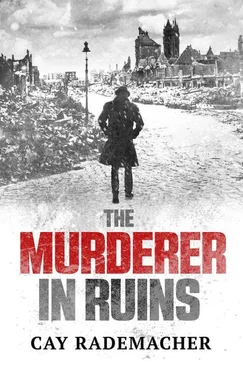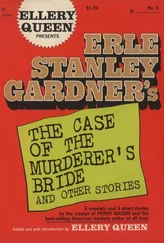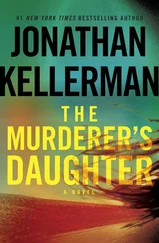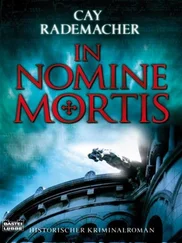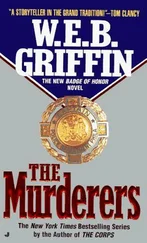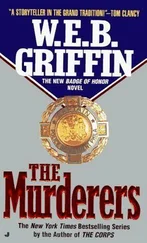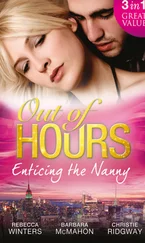Cay Rademacher - The Murderer in Ruins
Здесь есть возможность читать онлайн «Cay Rademacher - The Murderer in Ruins» весь текст электронной книги совершенно бесплатно (целиком полную версию без сокращений). В некоторых случаях можно слушать аудио, скачать через торрент в формате fb2 и присутствует краткое содержание. Год выпуска: 2015, ISBN: 2015, Издательство: Arcadia Books Limited, Жанр: Триллер, на английском языке. Описание произведения, (предисловие) а так же отзывы посетителей доступны на портале библиотеки ЛибКат.
- Название:The Murderer in Ruins
- Автор:
- Издательство:Arcadia Books Limited
- Жанр:
- Год:2015
- ISBN:9781910050750
- Рейтинг книги:5 / 5. Голосов: 1
-
Избранное:Добавить в избранное
- Отзывы:
-
Ваша оценка:
- 100
- 1
- 2
- 3
- 4
- 5
The Murderer in Ruins: краткое содержание, описание и аннотация
Предлагаем к чтению аннотацию, описание, краткое содержание или предисловие (зависит от того, что написал сам автор книги «The Murderer in Ruins»). Если вы не нашли необходимую информацию о книге — напишите в комментариях, мы постараемся отыскать её.
The Murderer in Ruins — читать онлайн бесплатно полную книгу (весь текст) целиком
Ниже представлен текст книги, разбитый по страницам. Система сохранения места последней прочитанной страницы, позволяет с удобством читать онлайн бесплатно книгу «The Murderer in Ruins», без необходимости каждый раз заново искать на чём Вы остановились. Поставьте закладку, и сможете в любой момент перейти на страницу, на которой закончили чтение.
Интервал:
Закладка:
‘What was your business at the Hansaplatz?’ he asks.
‘The usual. A meeting with a British officer at the station. I got hold of a passable copy of Caspar David Friedrich’s The Monk by the Sea , horrible frame, pseudo-baroque, gilded with lots of chips on it. But it’s an oil and done by somebody who knew what he was doing.’
‘Did you get a good deal?’
She smiles, but says nothing.
Stave wondered if she had palmed it off on the Brit as an original. American officers, according to popular wisdom, were so ignorant they’d buy any old rubbish. But the English? He didn’t press her. Otherwise she’ll just take me for a typical policeman, he told himself. Out loud he said, ‘Do you fancy taking a look at some original Friedrichs? We could take a stroll through the Kunsthalle?’
It was only a short walk, just a few minutes from the station, where three trains with steam pouring from their funnels had pulled in. ‘There must be coal supplies again,’ said Stave. ‘I can’t remember the last time I saw more than one train in the station.’
‘I guess that means they’ll be starting domestic deliveries again; with any luck we’ll be able to get warm by the time summer comes,’ Anna von Veckinhuasen replied. ‘I don’t mean to be sarcastic. Everybody’s doing what they can.’
They turned right past the station and 200 metres ahead of them the Kunsthalle loomed: a great grey box with a rotunda crowned by a dome, like a side of bacon with a musket ball stuck in it. The imposing facade of the old museum was dirty, but almost undamaged. A few scars caused by bomb shrapnel, streaks of smoke on the cornices. In front of the rotunda stood an ancient oak tree with a trunk thicker than the columns on the facade.
‘Incredible that that tree’s still unharmed,’ Stave commented.
‘There are always survivors, even in the plant world.’
In the shadow of the oak tree stood a tall bronze statue of a man on a horse, naked save for an antique helmet. ‘Rider,’ Stave read the inscription on the plaque below. ‘I’d never have guessed.’
‘There’s another miracle for you,’ Anna von Veckinhausen said. ‘That the thing wasn’t melted down.’
‘Some Nazi obviously liked it, or at least preferred it to the church bells. They were all melted down to make hand-grenade casings.’
Stave bought two entrance tickets. His companion nodded gratefully.
‘How did you know that the Kunsthalle was open again?’
‘I didn’t. We’re just lucky,’ Stave replied.
The museum had re-opened shortly after the end of the war. The collection had been housed either in bank safes or in the concrete bunker at Heiligengeistfeld, at least those works that the brownshirts had not declared to be entartet , unworthy to be considered art. The latter had all been sold off abroad, cheap. But in winter it had been impossible to heat the great galleries, not least because some of the roofs had been damaged and only partly patched up. So the museum had been closed and in fact this warm day was the first of the new season.
Most people, however, were out enjoying the sunshine, and hardly anybody thought of spending the precious daylight hours indoors. As a result Stave and Anna von Veckinhausen had the museum almost to themselves, and were able to wander leisurely from gallery to gallery. Some had black streaks down the walls from water coming in, and others were suspiciously empty, notably those that had been dedicated to modern art. Even so they enjoyed strolling slowly past the masterpieces. What is it that I like most, Stave asked himself, and answered: it’s the colours. The oils and watercolours, the blues and reds, the yellows and greens, the gold of the old masters – it was a treat for the eye, in contrast to the grey and black of the ruins, the brown of people’s clothing.
Anna von Veckinhausen was still on his arm. He wondered what she was thinking. They were both silent.
Eventually they reached the gallery with the works of Caspar David Friedrich. Stave stared at the fantastic landscapes and the tiny figures: women in bonnets, men in old-fashioned traditional dress, all of them with their backs to the spectator. He spent a long time over the painting entitled Eismeer , of a ship crushed between mighty ice floes. Once upon a time he had considered it surreal but after this winter it no longer seemed so. It was years since he had last been in here. With Margarethe. He quickly suppressed the memory.
Stave nodded at the paintings and said, ‘It’s funny to think that these are little more than 100 years old. To me, now, they seem like relics from the ancient world, on another continent.’
‘That’s what they are. Nothing Friedrich saw still exists, nothing he believed in is believed any more.’
‘But the works are still displayed on the walls here. And people come to see them. Like us.’
‘Because we long for those long-gone days. Because we feel we’ve lost something, but we don’t know what it is.’
‘There again, Caspar David Friedrich would have liked that.’
‘But only that. He painted picturesque ruins into woods and mountains. If he were to see the ruins here today, he’d soon lose his taste for gaping windows and ruined walls.’
She put her free arm across her chest, and shuddered. ‘I need to get out of here, back into the sunlight.’
From the museum it was only a short stroll across the broad pavements of the Glockengiesserwall to the Inner Alster. Before the war the river, turned into a giant square here by two dams, had reflected Hamburg’s most famous facades – the Jungfernstieg. The psychologist’s practice was just opposite the Glockengiesserwall. There were trees along the embankment, promenades, the offices of important shipping companies behind the facades, and the spires of the city’s churches towering above the glistening tiled roofs. Before the war the citizens of Hamburg would stroll up and down here in their Sunday best, and now they were here again, trying to ignore the cracks in the facades and their own dowdy dress.
Stave and his companion made their way carefully over the temporarily repaired rail tracks to the Ballindamm, around two empty, long-abandoned wagons which up until the beginning of the winter workers had used to bring rubble from the town and tip it into the Alster. The ice on the river no longer glittered, but lay there white and watery in the sunlight, like spilt milk. Yet only on the surface. The ice below was still up to three metres thick. A few intrepid souls were skating in wide circles on it, sending little sprays of water up behind them. Most people stayed on the embankment, as if it were somehow unseemly to venture on to the ice.
Stave shivered. The cold rising from the Alster reminded him of the morgue. Maybe because he was taking a casual walk, something he was unused to doing. Going for a walk along the waterfront was an activity that was simultaneously pointless and an end in itself: you walk along the riverfront without following any particular route because no one route mattered more than any other; when you went for a walk you ended up where you started from. It was as if this casual walk, this feeling of doing something and at the same time doing nothing, was untying a knot in his soul.
And suddenly the chief inspector began to talk, unaware of how or why he started, but he talked about his son in Siberia and how they’d argued back in the summer of 1945 when he set out for the front. About his son’s scorn for his father, and his youthful enthusiasm, so painfully genuine, so horribly misled. About Margarethe and the night she died in the bombing. About the rubble murderer, who turned out to be one of his colleagues. And a Jewish family fleeing to find a new home who got stranded amidst the ice in a hostile city. A city with a murderer at large, a murderer whose fate and theirs were inextricably linked. About Lothar Maschke, who was really Hans Herthge, about whom he now knew a lot but not everything – things he couldn’t believe. But what was the point of knowing something if that knowledge had no consequence.
Читать дальшеИнтервал:
Закладка:
Похожие книги на «The Murderer in Ruins»
Представляем Вашему вниманию похожие книги на «The Murderer in Ruins» списком для выбора. Мы отобрали схожую по названию и смыслу литературу в надежде предоставить читателям больше вариантов отыскать новые, интересные, ещё непрочитанные произведения.
Обсуждение, отзывы о книге «The Murderer in Ruins» и просто собственные мнения читателей. Оставьте ваши комментарии, напишите, что Вы думаете о произведении, его смысле или главных героях. Укажите что конкретно понравилось, а что нет, и почему Вы так считаете.
